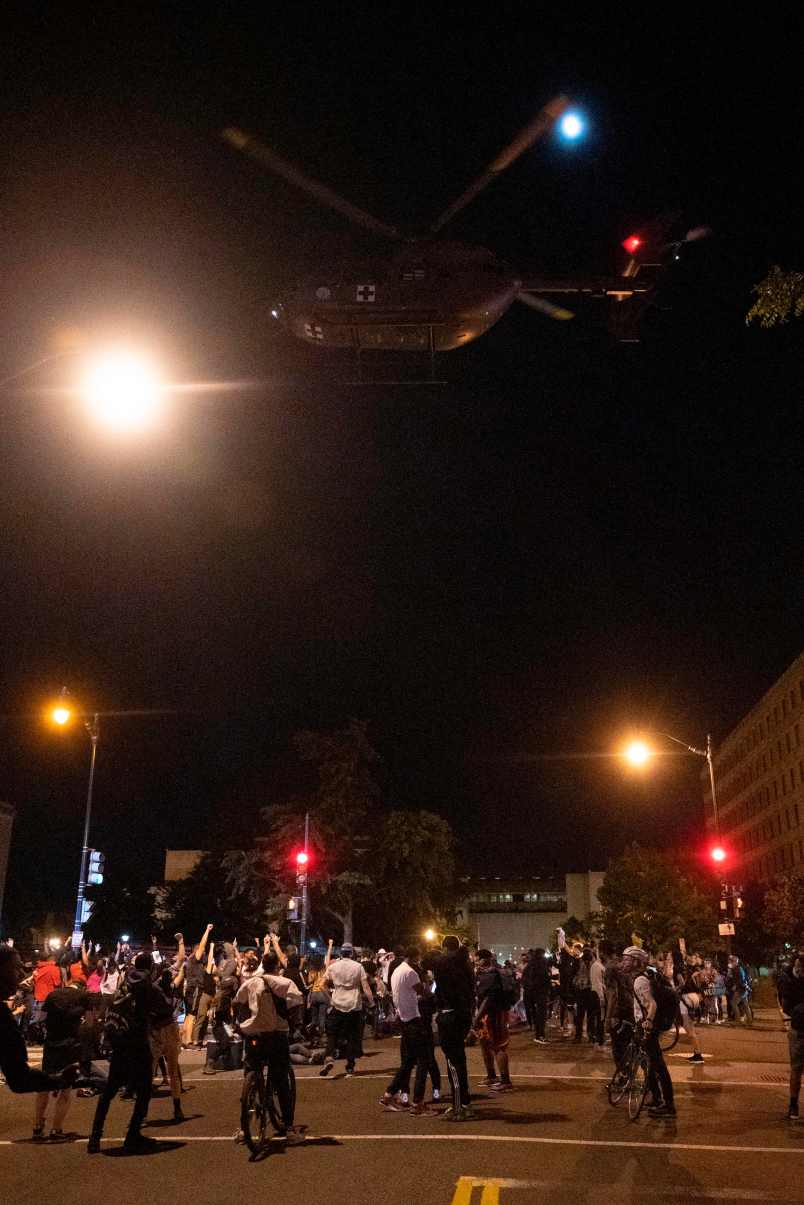Monday night’s D.C. protests saw something nearly unprecedented.
Starting after around 10 p.m. ET on Monday evening, protestors were treated to thumping helicopter engines, deafening noise and violent downwash from rotors spinning on military choppers hovering low over the crowds.
Now, the military is investigating the episode.
Secretary of Defense Mark Esper confirmed at a Wednesday press conference that it was a national guard helicopter that “hovered low” above the protestors.
“I directed the secretary of the Army to conduct an inquiry to determine what happened and why and report back to me,” he said.
“When you’re landing that low in a city, it looks unsafe to me,” he said. “it would not be unsafe if they were medevacing or picking up someone who was seriously injured.”
“To my understanding, it wasn’t [a medevac mission],” Esper added.
The D.C. National Guard said in a statement that it was investigating the matter.
“Our priority is the safety of our Guardsmen who support civil authorities,” the statement reads. “We are dedicated to ensuring the safety of citizens and their right to protest.”
DCNG Commanding General has directed an investigation into the actions of our rotary aviation assets June 1. Our priority is the safety of our Guardsmen who support civil authorities. We are dedicated to ensuring the safety of citizens and their right to protest.
— District of Columbia National Guard (@DCGuard1802) June 3, 2020
Wow. Blackhawk helicopters flying low in DC and appear to be using downdraft to disperse peaceful protestors.
NBC’s @jackiebensen video: pic.twitter.com/AchhXls400
— Joyce Karam (@Joyce_Karam) June 2, 2020
Military experts described in conversations with TPM the use of aircraft as a “show of force” to intimidate an enemy.
“In Afghanistan it became sort of a tactic when Taliban fighters were either engaged in an attack in a settled area or near civilians for U.S. jets to be used to fly over them as an initial means of trying to disperse them or to get civilians away from a situation,” Jason Campbell, a RAND corporation researcher and former Afghanistan country director in the office of the secretary of defense, told TPM, adding that it had been used “in Mogadishu in ’93, when they were confronted by some of the fighters on the ground were meshed in with civilians, there they did use rotary wing helicopters to disperse the crowd.”
“The fact that it was a medical helicopter especially is unsettling,” Campbell added.
Michael Canders, a former Air Force rescue helicopter pilot and aviation center director at Farmingdale State College, told TPM that “it’s not a good idea.”
Canders recalled flying rescue missions in New Orleans during Hurricane Katrina in which the force of the rotor downwash from his modified Black Hawk helicopter “blew the shingles off” houses beneath.
“On the street there are potential projectiles – there’s so much downside to it,” he added.
Jonathan Schroden, director of CNA’s Special Operations Program, who has deployed to Afghanistan, told TPM he was “surprised to see it used as a tactic.”
“The odds of potentially hurting someone — causing a panic that hurt someone, or causes debris to swirl around — is relatively high,” he said.
Military helicopters trying to disperse protesters here in DC pic.twitter.com/md6hYVqE7u
— Katie Hill (@KatieHill4CA) June 2, 2020
The Army field manual’s section on “civil disturbance operations” describes the use of helicopters as a “show of force” against unarmed, civilian crowds.
“Display force in a graduated manner, such as a helicopter hovering over a crowd or soldiers with charged weapons,” the manual reads. “Exploit the psychological effect of a show of force.”
It remains unclear if the intent of the pilots was to merely demonstrate a “show of force” or to utilize rotor downwash, using it to blow people away. Reports differed on the source of the order to use the choppers. The New York Times reported that the “maneuvers were personally directed by the highest echelons of the Washington National Guard,” while the AP reported that President Trump himself ordered the operation.
The tactic of using helicopters as a show of force and, more specifically, the downward force generated by their high-powered rotors to intimidate or disperse crowds, extends back until at least the 1960s.
But mostly, the use of rotor downwash to disperse people seems to be improvisational.
Kyleanne Hunter, a fellow at CNAS and a former military helicopter pilot, told the Washington Post that, while deployed to Iraq, she would fly low to scatter civilian vehicles.
It pops up in government reports on various rotor-based aircraft.
One 1960s Marine Corps report on the “use of helicopters” for “Communist mob control” extols the idea of choppers for crowd control.
A 2001 Senate Defense Committee report on the V-22 Osprey notes that “downwash had the potential to be enhancing for some areas of low-intensity conflict. It may be an effective method to use to control unarmed crowds.”






